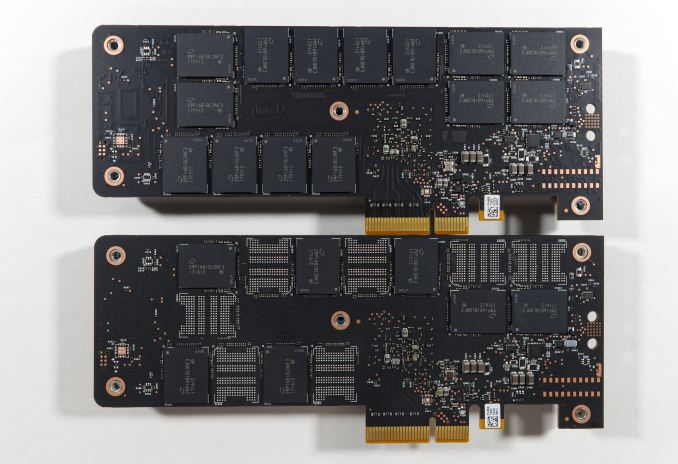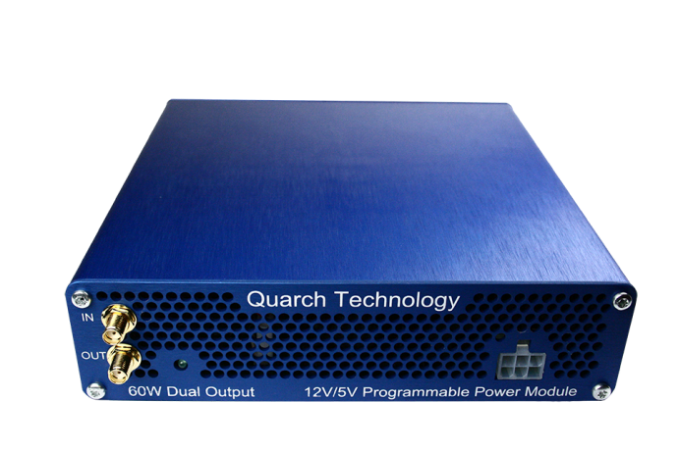The Intel Optane SSD 900p 480GB Review: Diving Deeper Into 3D XPoint
by Billy Tallis on December 15, 2017 12:15 PM EST
Our first look at the Intel Optane SSD 900p only included the smaller 280GB capacity. We now have added the 480GB model to our collection, and have started analyzing the power consumption of the fastest SSDs on the market.
This second look at the Optane SSD 900p doesn't change the overall picture much. As we speculated in our initial review, the design of the Optane SSD and its 3D XPoint memory means that performance does not scale with capacity the way most flash-based SSD designs do. The Optane SSD 900p uses a controller with seven channels for communicating with the 3D XPoint memory. The difference between the 280GB and 480GB models is merely a difference of three or five 3D XPoint dies per channel. Of the 28 memory package locations on the PCB, the 280GB model populates 21 with single die packages. The 480GB model uses all 28 spots, and half of the packages on the front are dual-die packages.
A single NAND flash die isn't enough to keep one of the controller's channels busy, because flash takes many microseconds to complete a read or write command, and even longer for erase commands. By contrast, 3D XPoint memory is fast enough that there is little to no performance to be gained from overlapping commands to multiple dies on a single channel. Increasing the number of dies per channel on an Optane SSD affects capacity and power consumption but not performance.
Intel recently let slip the existence of 960GB and 1.5TB versions of the 900p, through the disclosure of a product change notification about tweaks to the product labeling. The specifications for the larger capacities have not been confirmed but likely match the smaller models in every respect except power consumption. Since Intel has not officially announced the higher capacities yet, no MSRP or release date is available.
| Intel Optane SSD 900P Specifications | ||||
| Capacity | 280 GB | 480 GB | 960 GB | 1.5 TB |
| Controller | Intel SLL3D | |||
| Memory | Intel 128Gb 3D XPoint | |||
| Interface | PCIe 3.0 x4 | |||
| Form Factor | HHHL Add-in card or 2.5" 15mm U.2 |
HHHL Add-in card | HHHL Add-in card (U.2 unknown) |
|
| Sequential Read | 2500 MB/s | TBD | ||
| Sequential Write | 2000 MB/s | TBD | ||
| Random Read IOPS | 550k | TBD | ||
| Random Write IOPS | 500k | TBD | ||
| Power Consumption | 8W Read 13W Write 14W Burst 5W Idle |
<20.5 W | <24 W | |
| Write Endurance | 10 DWPD | TBD | ||
| Warranty | 5 years | TBD | ||
| Recommended Price | $389 ($1.39/GB) | $599 ($1.25/GB) | TBD | TBD |
Our SSD power measurement equipment burned out right before our first Optane SSD arrived. As of this week, we have newer and much better power measurement equipment on hand: a Quarch XLC Programmable Power Module. We'll explore its capabilities more in a future article. For now, we're filling in the missing power measurements from the past several reviews. Both of the Optane SSD 900p models have been re-tested with the Quarch power module on the entire test suite except for The Destroyer (so far). We haven't yet thoroughly validated the new power measurements against the results from our old meter so there may be some discrepancies, but the Optane SSDs draw so much power that any minor differences won't matter to this review. Everything that was tested with the old meter will eventually be re-tested on the Quarch power module, but we don't expect significant changes except to idle power measurements (where the Quarch power module should offer higher resolution).
Our first review of the Optane SSD 900p included a few puzzling results, most notably slightly higher performance when the ATSB Heavy and Light tests were run on a filled drive than when the Optane SSDs were freshly erased. One potential factor for this has since come to light: After first being powered on, Intel Optane SSDs perform a background data refresh process. This isn't necessary unless the SSD has been powered off for a long time, but the drive has no way to know how long it was without power. The documentation for the 750GB Optane SSD DC P4800X states this process can take up to three hours. We have not observed any clear transition in idle power during the first few hours after power-on, but there are occasional short periods where idle power drops by around 350-400mW (from around 3.5W).
Without a conclusive indication of whether background data refresh is happening and influencing benchmark results, we've re-tested the 280GB Optane SSD 900p for this review. Before running the synthetic benchmarks, the 900p was allowed to sit at idle for at least three hours. The ATSB tests were also conducted after an extended idle period, but the test system was rebooted between ATSB tests. Even with this precaution, there's still significant variability between test runs on the Optane SSD 900p and the full-drive performance is often better than freshly erased, so it appears there's another factor contributing to this behavior.
| AnandTech 2017 SSD Testbed | |
| CPU | Intel Xeon E3 1240 v5 |
| Motherboard | ASRock Fatal1ty E3V5 Performance Gaming/OC |
| Chipset | Intel C232 |
| Memory | 4x 8GB G.SKILL Ripjaws DDR4-2400 CL15 |
| Graphics | AMD Radeon HD 5450, 1920x1200@60Hz |
| Software | Windows 10 x64, version 1703 |
| Linux kernel version 4.12, fio version 2.21 | |
- Thanks to Intel for the Xeon E3 1240 v5 CPU
- Thanks to ASRock for the E3V5 Performance Gaming/OC
- Thanks to G.SKILL for the Ripjaws DDR4-2400 RAM
- Thanks to Corsair for the RM750 power supply, Carbide 200R case, and Hydro H60 CPU cooler
- Thanks to Quarch for the XLC Programmable Power Module and accessories












69 Comments
View All Comments
eddman - Sunday, December 17, 2017 - link
That graph explains the situation perfectly. Even if the media's latency was somehow magically reduced to zero, the total storage latency would still be only about 6 times better.It's all pointless though; ddriver's personal hatred towards intel and "the corporations" prevents him from thinking differently. As soon as he finds a number that is different from what was mentioned in the promotional materials, the first thing he does is to start shouting "liar, liar".
P.S. I have zero love for corporations and can't stand when one takes advantage of the users. What I also can't stand is a person spreading unsubstantiated claims and spamming a technology website's comment section to offload his hate in order to feel better.
tuxRoller - Friday, December 15, 2017 - link
Also z nand appears to be mlc cells operating in SLC mode, and that's still slower than first gen xpoint.hescominsoon - Friday, December 15, 2017 - link
Intel has walked back the 100x bs claims. Also notice how micro(their partner in this venture) has NOT released their side of this product?https://semiaccurate.com/?s=optane
tuxRoller - Saturday, December 16, 2017 - link
They walked them back? Maybe for these nvme products, though I've not seen anything about that. The real test is how well they'll do as direct addressed memory when used in the DIMM configuration.Reflex - Friday, December 15, 2017 - link
SLC has no significant advantages over Optane. Optane is nearly across the board a better performer, often by a significant margin, than any commercial NAND technology. The two drawbacks that are important right now are power consumption and cost (these are also drawbacks of SLC for the record)The complaints about Intel's 'hype' are misconstrued. There is a huge difference between discussing what a technology is capable of, and what individual products derived from that technology can deliver. That some people had reading comprehension problems is not Intel's problem, they are delivering what they promised, and as the rest of the supporting infrastructure improves over time we know based on their initial statements that Optane/PCM can scale to match it.
CheapSushi - Friday, December 15, 2017 - link
The industry is trying. It's called Z-NAND.ddriver - Friday, December 15, 2017 - link
Which is MLC...Samsung realized nobody is catching up in the nand market and decided to push consumer, high end and mainstream enterprise a notch down to TLC.
So now that MLC is only a "high end enterprise" thing in their portfolio, they decided to pimp it up with a new moniker - z-nand. Alas, it is just good old MLC with a barely incremental controller. And claim that it has anything to do with SLC performance - which it does as much as an a race horse harness makes an old donkey faster.
They REALLY aren't trying.
CheapSushi - Saturday, December 16, 2017 - link
It's MLC & TLC 3D NAND treated exactly like SLC (1 bit per cell) with a better controller and special sauce, effectively making it as if it was SLC in the first place and a better SLC driver than previous SLC drives that came out. So what is the issue? It's not a completely separate NAND production line?ddriver - Saturday, December 16, 2017 - link
Do you realize parroting nonsense you are clearly completely ignorant of doesn't win you bonus points?There is no such thing, you have to compromise one for the sake of the other. It is just more mature and a tiny bit better than previous gen MLC, but it is not even half of what can be squeezed of contemporary SLC.
"Special sauce"? It is sad to see average Joe hans't moved up a bit since the middle ages.
drajitshnew - Saturday, December 16, 2017 - link
No "ryzen" in opposition to their "core". The flash industry is in a race to see who can make the CHEAPEST PoS